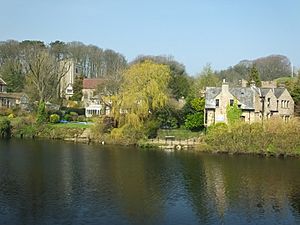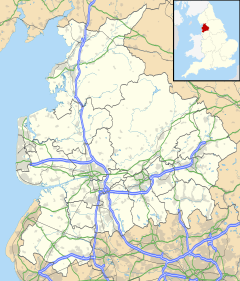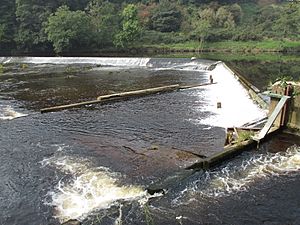Halton-with-Aughton facts for kids
Quick facts for kids Halton-with-Aughton |
|
|---|---|
 Halton village, viewed from the far river bank |
|
| Population | 2,277 (2011) |
| OS grid reference | SD502648 |
| Civil parish |
|
| District | |
| Shire county | |
| Region | |
| Country | England |
| Sovereign state | United Kingdom |
| Post town | LANCASTER |
| Postcode district | LA2 |
| Dialling code | 01524 |
| Police | Lancashire |
| Fire | Lancashire |
| Ambulance | North West |
| EU Parliament | North West England |
| UK Parliament |
|
Halton-with-Aughton is a lovely area in England. It's a civil parish and an electoral ward. You can find it about 3 miles (5 km) east of Lancaster. This area sits on the north side of the River Lune.
The main part is the village of Halton, also called Halton-on-Lune. It's in the west. The parish then stretches all the way to a smaller place called Aughton in the east. Halton-with-Aughton is part of the City of Lancaster district in Lancashire. About 2,227 people live here.
Contents
Exploring Halton Village
Halton village has many modern homes. You can also spot some older buildings from the 1600s and 1700s. The village has its own primary school. There's also a post office and other local shops. A very popular community centre is here too. The village is close to the new Heysham to M6 Link Road.
The old Halton railway station was across the river. A narrow toll bridge connected it to the village. The station closed in 1966. Today, the station building is used by Lancaster University as a boat house. It sits next to a cycle path. This path was once the old "little" North Western Railway line.
Halton's Past
Halton was a very important place long ago. Before the Norman Conquest, it was a big manor owned by Earl Tostig. He was the brother of King Harold. After the Normans took over, the new rulers preferred Lancaster.
In the 1800s, textile mills used the power of the River Lune. On Castle Hill, you can still see signs of an old motte and bailey castle. This castle was built by the Normans in the 1000s. In the churchyard of St Wilfrid's Church, there's the Halton Cross. People believe Norsemen carved it over 1,000 years ago.
Halton Castle was once in the village. It was likely a motte and bailey castle built in the late 1000s. But Halton became less important in the 1100s. People started to favor Lancaster more. So, Halton Castle was left empty. Only earthworks remain today. It's on private land, so you can't visit it.
Halton Hall was also part of the Halton area. It stood by the River Lune for many centuries. But it was taken down in the 1930s.
Old Industries of Halton
In 1752, a special furnace was built near Cote Beck. This furnace used charcoal to make pig iron. By 1755, the Halton Furnace Company ran it. They also had furnaces in Leighton and Caton. These furnaces made about 20 tons of pig iron each week. Pig iron is a type of iron with a lot of carbon.
Later, this iron was made purer in special forges. A big trip hammer was used to shape the metal. There were two forges on the river in Halton. One had six water-wheels! By 1800, most charcoal furnaces were replaced by coke furnaces. But Halton's furnace kept going until 1845. Today, nothing is left of these old industries.
The river banks were very busy in the 1700s. Two cotton mills were built there. They used water power from the river. These were Forse Bank mill (1744) and Low Mill. Not much of them remains now. Forse Bank mill, later called Forge Bank Mill, was upstream. Water from above the weir powered all the buildings.
These mills started separately but later joined. Forse Bank first spun flax, then cotton. After the Lancashire Cotton Famine in 1861, cotton spinning stopped. But in 1862, the mill started making oilcloth. Eventually, a company called Williamson bought it. They moved their linoleum and oilcloth making to Lancaster. Cotton weaving stopped in 1941. Part of the old mill site now has new eco-friendly homes. More homes are being built there.
Halton's Railway History
In 1849, the "little" North Western Railway built Halton station. It was on the other side of the Lune. A ferry first linked it to Halton village. Sadly, eight people died when this ferry tipped over. In December 1849, the railway company built a toll bridge.
This bridge was washed away and rebuilt in 1869. It was rebuilt again in 1913. When the railway closed in 1966, the bridge fell apart. But it has been fixed up! Now it's free to use for small cars, walkers, and cyclists.
The first wooden station building burned down on April 3, 1907. A spark from a passing train started a fire in a wagon of oil drums. The fire brigade couldn't cross the narrow bridge. So, railway workers from Lancaster had to pass buckets of water from the river. The station was rebuilt with brick and wood. That building is still there today! It's used for storage by Lancaster University Rowing Club. The old track area is now a public car park. The bridge is part of National Cycle Network Route 90. The old trackbed is on Route 69.
Discovering Aughton

Aughton was called 'Actun' in the old 1086 Domesday Book. This name means "a place where oak trees grow." Aughton is a small riverside place, or hamlet, by the River Lune. It has many stone cottages. You'll also find St Saviour's Church here. The church is on Aughton Road, north of the hamlet. It was built in 1864. A famous architect named E. G. Paley designed it. Aughton is located inside the beautiful Forest of Bowland Area of Outstanding Natural Beauty.
Every 21 years, something special happens in Aughton. They bake a giant "Aughton Pudding" over a fun weekend! The pudding made in 1992 was even in the Guinness Book of Records as the largest. The festival in 2013 was a big success. They didn't try for a world record that time. But over 5,000 people came! The money they made was given to good causes. This included St Saviour's Church and the Recreation Rooms. This money later helped bring super-fast 1 Gigabit per second broadband internet to the village on August 14, 2014.



